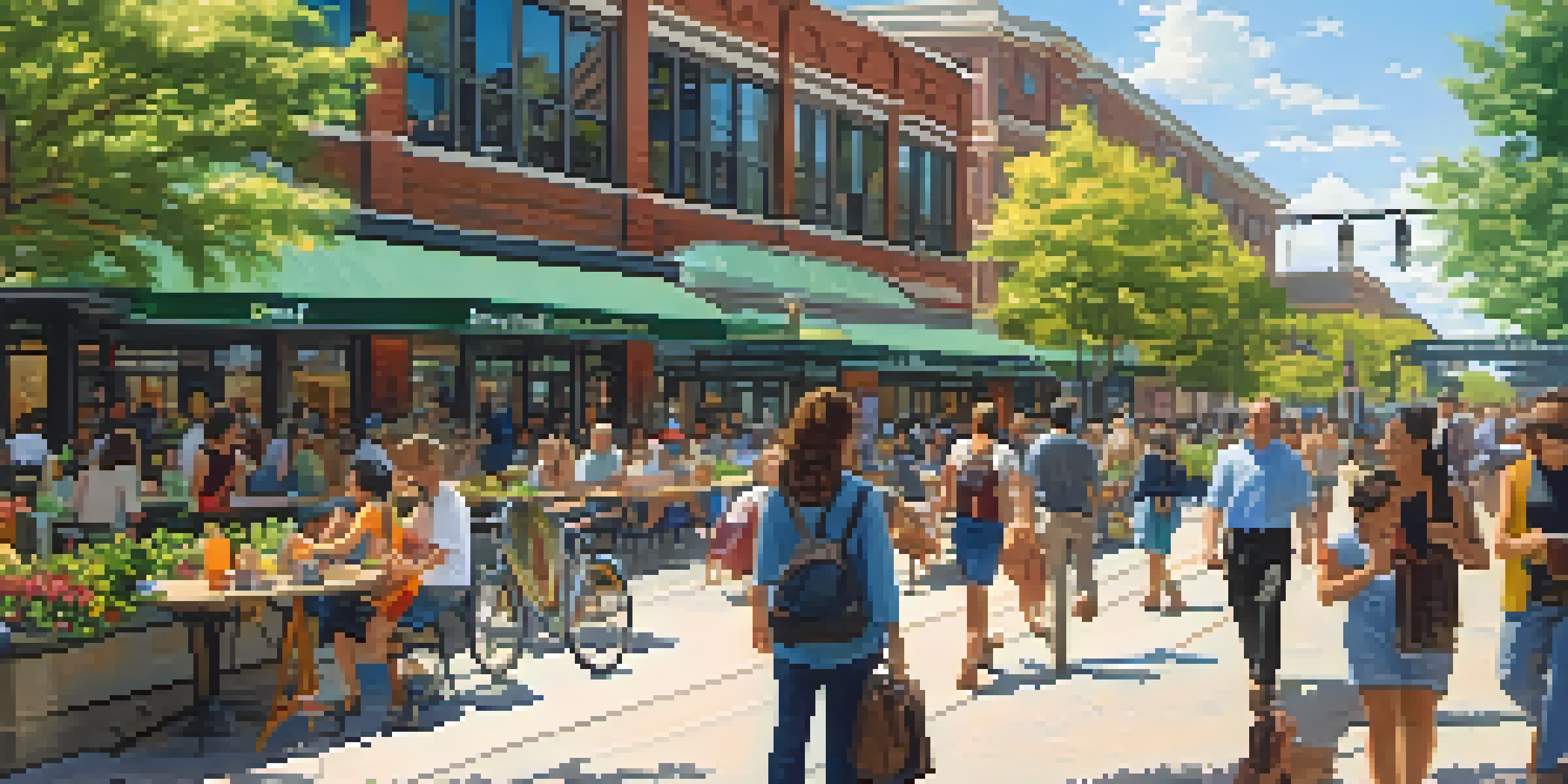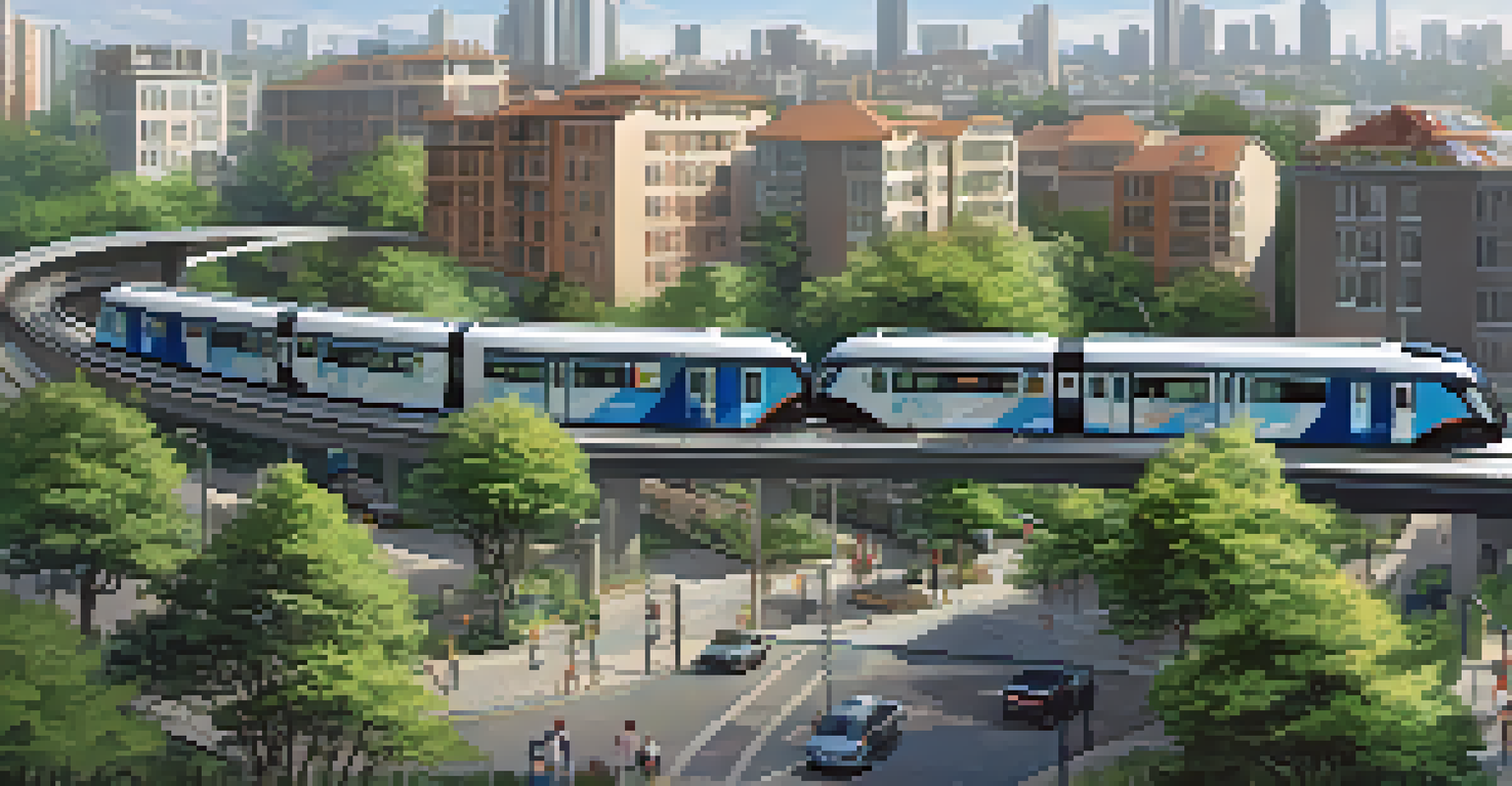Transit-Oriented Development: A Path to Sustainable Cities

Understanding Transit-Oriented Development (TOD)
Transit-Oriented Development, often shortened to TOD, refers to a design approach that focuses on creating vibrant communities around high-quality public transport systems. This concept aims to reduce reliance on cars, promoting walkability and accessibility. By clustering residential, commercial, and recreational spaces near transit hubs, TOD encourages sustainable living and a healthier lifestyle.
The greatest cities are not those that are the largest or the richest, but those that are the most livable.
Imagine a city where you can step out of your home and easily access a train or bus that takes you to work, school, or leisure activities. This convenience not only makes daily commuting easier but also fosters a sense of community as residents are more likely to interact with one another in shared spaces. In essence, TOD transforms urban areas into interconnected ecosystems that prioritize people over vehicles.
As cities continue to expand, the importance of effective land use becomes clear. TOD seeks to tackle urban sprawl by ensuring that development occurs in a way that is both environmentally sustainable and economically viable. The focus on public transport not only benefits the environment but also enhances the quality of life for residents, making it an attractive option for urban planners.
The Environmental Benefits of TOD
One of the most compelling arguments for Transit-Oriented Development is its positive impact on the environment. By reducing the need for personal vehicles, TOD significantly lowers greenhouse gas emissions and air pollution. Fewer cars on the road mean cleaner air and a healthier planet, which is crucial as we face the challenges of climate change.

Additionally, TOD promotes the use of alternative modes of transport, such as biking and walking, which contribute to a reduction in carbon footprints. Cities designed with pedestrians in mind often have more green spaces, which not only improve air quality but also enhance biodiversity within urban areas. This balance between development and nature creates a more harmonious living environment.
TOD Promotes Sustainable Living
Transit-Oriented Development creates vibrant communities that prioritize public transport, reducing reliance on cars and fostering healthier lifestyles.
Moreover, with public transport systems being more energy-efficient than individual cars, the overall energy consumption of a city can be greatly reduced. For instance, cities that invest in light rail or bus rapid transit can transport a higher number of people with less energy than traditional vehicle-based commuting. This shift is crucial for building sustainable urban futures.
Economic Advantages of Transit-Oriented Development
Beyond environmental benefits, TOD can also drive economic growth. By concentrating development around transit stations, cities can boost local businesses as more foot traffic flows through these areas. This increased accessibility can attract investment, creating jobs and enhancing the overall economic viability of a community.
Sustainable development is about the future of our children and the future of our planet.
Think about it: when people can easily access shops, restaurants, and services without needing a car, they are more likely to spend money locally. This not only supports small businesses but also encourages the growth of a vibrant local economy. More jobs and thriving businesses lead to a healthier tax base for cities, which can then be reinvested into public services and infrastructure.
Furthermore, properties located near transit hubs tend to have higher values due to their desirable location. Homebuyers and renters often seek out these areas for the convenience they offer, leading to increased demand. This can create a win-win situation for developers and residents alike, as investments in TOD can yield significant returns.
Enhancing Community Connectivity Through TOD
A key feature of Transit-Oriented Development is its ability to enhance community connectivity. By designing neighborhoods that prioritize walking, biking, and easy access to public transport, TOD fosters stronger social ties among residents. People are more likely to engage with their neighbors and participate in community events when they can conveniently travel within their local area.
Consider a community where parks, schools, and shops are all within walking distance of a train station. This setup not only encourages physical activity but also nurtures a sense of belonging among residents. When people feel connected to their neighborhood, they are more inclined to take pride in their community and advocate for its well-being.
Economic Growth through TOD
By concentrating development around transit hubs, TOD boosts local businesses and enhances community economic viability.
Additionally, TOD promotes inclusivity by providing access to essential services for all residents, regardless of socio-economic status. When public transport systems are reliable and affordable, they empower individuals to seek employment, education, and healthcare opportunities, breaking down barriers that might otherwise limit their potential.
Challenges Facing Transit-Oriented Development
While Transit-Oriented Development offers numerous benefits, it is not without its challenges. One significant hurdle is the need for substantial upfront investment in public transit infrastructure. Cities must commit resources to develop efficient and reliable transport systems, which can be daunting in times of budget constraints.
Moreover, there’s the risk of gentrification, where rising property values and rents may displace long-time residents. As neighborhoods become more desirable due to improved transit options, lower-income residents might find it increasingly difficult to afford living in those areas. Addressing these social equity concerns is essential to ensure that TOD benefits everyone.
Lastly, effective planning and coordination between various stakeholders, including government agencies, private developers, and the community, are crucial for successful TOD implementation. Without a unified vision and collaboration, the potential of Transit-Oriented Development can fall short, leading to fragmented and ineffective results.
Global Examples of Successful TOD
Looking around the world, we can find numerous examples of successful Transit-Oriented Development that illustrate its potential. Cities like Copenhagen and Tokyo have integrated robust public transport systems with urban planning, resulting in vibrant, sustainable communities. These cities showcase how effective TOD can lead to not just functional transportation but also thriving neighborhoods.
In Copenhagen, the integration of cycling with public transport has created a city where bikes and trains coexist seamlessly. Residents enjoy easy access to a network of bike lanes and train stations, making it one of the most bike-friendly cities globally. This commitment to sustainable transport has significantly reduced car dependency and fostered a healthy lifestyle.
Community Connectivity Enhanced
TOD fosters stronger social ties and inclusivity by designing neighborhoods that prioritize walking, biking, and access to essential services.
Similarly, Tokyo’s extensive rail network has shaped its urban landscape, allowing for high-density living without sacrificing quality of life. The city's approach to TOD has created bustling districts that offer everything from shopping to entertainment, all easily reachable via public transport. These examples demonstrate that with thoughtful planning, TOD can lead to sustainable urban living.
The Future of Transit-Oriented Development
As cities continue to grow and evolve, the future of Transit-Oriented Development looks promising. With an increasing focus on sustainability and reducing carbon footprints, more urban planners are recognizing the value of integrating public transport with community development. This shift in perspective is paving the way for more innovative and eco-friendly urban designs.
Emerging technologies, such as electric and autonomous vehicles, are also poised to complement traditional public transport systems. By embracing these innovations, cities can create even more efficient transit networks that cater to diverse community needs. The combination of new tech and TOD principles can lead to smarter cities that prioritize both accessibility and sustainability.

Ultimately, the success of Transit-Oriented Development hinges on community involvement and advocacy. As residents become more engaged in the planning process, they can advocate for their needs and ensure that developments align with their vision for a sustainable future. This collaborative approach will be key in shaping the next generation of urban living.